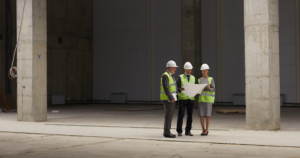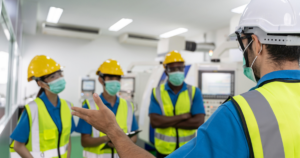Within an organization, a committee called the Safety Committee is tasked with maintaining a safe and healthy work environment. Its main goals are to detect and resolve possible risks, put safety procedures into place, and encourage a culture of well-being among staff members. Typically, the committee is made up of representatives from different organizational levels and departments.
What is a Safety Committee?

Overview of Safety Committee
Safety Committees play a crucial role in fostering a proactive approach to workplace safety. They can more accurately evaluate and reduce risks by combining different points of view, which will ultimately lead to fewer accidents and injuries. These committees facilitate information sharing about safety concerns by acting as a conduit for communication between staff and management.
Benefits of the Safety Committee
- Improved Safety Culture: Safety Committees play a role in fostering a culture that places a high priority on safety, which raises awareness and encourages adherence to safety protocols.
- Decreased Incidents: Accidents, injuries, and occupational illnesses are reduced when possible hazards are proactively identified and mitigated.
- Engagement of Employees: Giving workers a say in safety decisions increases their sense of ownership and engagement, which boosts morale and increases job satisfaction.
- Legal Compliance: Ensuring that an organization complies with occupational health and safety regulations is crucial, and Safety Committees are essential in facilitating this process.
- Increased Productivity: Employees who feel more secure and can concentrate on their work without having to constantly worry about potential hazards tend to be more productive in a safer workplace.
- Cost Savings: By lowering medical costs, compensation claims, and potential legal liabilities, reducing accidents and injuries not only protects people’s health but also saves money for the company.
- Positive Reputation: An organization’s reputation is enhanced by a strong commitment to workplace safety. This makes the company an appealing employer and may draw in additional business partners and clients who respect morality and responsibility.
- Data Analysis: The organization’s analytics team works with the Safety Committee to conduct routine analyses of safety-related data. For example, they may observe a pattern of slip-and-fall incidents occurring in a particular area regularly. Through data analysis, they determined that improved floor traction is required. The committee then suggests installing flooring that is resistant to slips to address the underlying cause and stop additional incidents.
- Equipment Maintenance: To create a schedule for preventive maintenance, the committee works closely with the maintenance division. This entails doing regular maintenance on equipment, making sure safety features are operating, and resolving any problems before they get worse. By taking preventative measures, the likelihood of accidents is greatly decreased and downtime from unplanned equipment failures is minimized.
- Health Promotion: The Safety Committee launches a wellness program after realizing the value of overall health. This includes stress management classes, ergonomic workshops to teach staff members how to set up their workstations correctly, and programs that support a healthy work-life balance. These initiatives improve the workforce’s mental and emotional health in addition to their physical health.
- Documentation and Record-Keeping: The committee keeps thorough documentation. In the event of an incident, thorough investigations are aided by comprehensive records, which help identify patterns and put preventive measures in place. Additionally, these records demonstrate the organization’s dedication to safety during audits and serve as documentation for regulatory compliance.
Responsibilities of the Safety Committee

- Risk assessment: Identify possible risks at work and rank them according to severity to determine which needs to be addressed first.
- Safety Training: Make sure all staff members are knowledgeable about safety procedures and protocols by organizing and carrying out safety training programs.
- Investigate mishaps or near-misses: Pinpoint the underlying causes, and suggest countermeasures to keep similar incidents from happening in the future.
- Policy Development: Work with management to create and revise safety policies, making sure they adhere to rules and guidelines set forth by the industry.
- Communication: Provide efficient channels for informing all staff members about safety issues, updates, and information.
- Emergency Preparedness: Create and update emergency response plans, making sure all staff members are aware of safety precautions and evacuation techniques.
- Frequent Inspections: Make sure that safety standards and laws are being followed by conducting regular safety inspections to find and address possible hazards.
- Data Analysis: Look for patterns or trends in safety-related data, such as incident reports and near-miss incidents, that can direct future safety initiatives.
- Work together with maintenance teams: It guarantees that all machinery and equipment meet safety regulations and receive routine maintenance to avoid malfunctions.
- Emergency Preparedness: Create and update emergency response plans, making sure all staff members are aware of safety precautions and evacuation techniques.
- Frequent Inspections: Make sure that safety standards and laws are being followed by conducting regular safety inspections to find and address possible hazards.
- Health Promotion: Encourage the general well-being of employees by starting initiatives that center on issues related to health, such as ergonomics, mental health, and nutrition.
- Record-keeping and Documentation: To monitor progress, proof of compliance, and a historical reference for upcoming evaluations, keep complete records of safety meetings, training sessions, and incidents.
Example:
Consider a manufacturing company that has a committee devoted to safety. This committee collaborates to maintain a safe workplace and is made up of representatives from production, maintenance, and administration. Conducting routine safety inspections is one of their main duties. They find a possible hazard—a broken conveyor belt in the production area—during a routine inspection.
The committee gets started right away by alerting the maintenance crew to the problem so that it can be fixed quickly. Concurrently, they arrange a quick training session for production staff, emphasizing the significance of promptly reporting equipment malfunctions. By taking a proactive stance, possible accidents in the future are avoided in addition to solving the current issue.
Conclusion
To sum up, safety committees are essential to preserving a safe and healthy work environment. By working together and being diligent, they lower the chance of incidents, promote employee well-being, and guarantee adherence to safety rules.
Reference
- Safety and health through integrated facilitied teams: https://www.ncbi.nlm.nih.gov/pmc/articles/PMC7526105/


